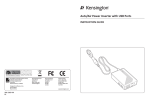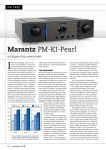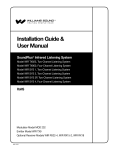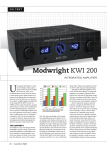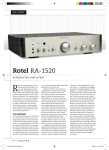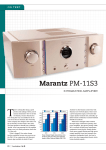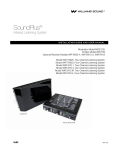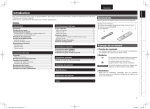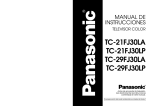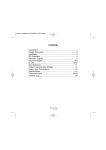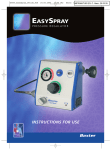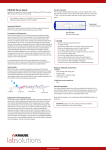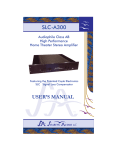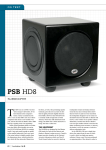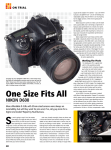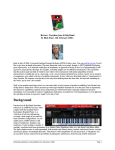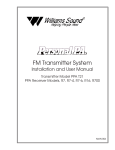Download Marantz PM-KI-Pearl-Lite
Transcript
ON TEST Marantz PM-KI-Pearl-Lite integrated AMPLIFIER 34 Australian Newport Test Labs I can almost hear the gasps of dismay when audiophiles take their first look at the Marantz PM-KI-Pearl-Lite. They’ll look at those tone controls on the front panel and say: ‘Tone controls? On an audiophile amplifier? Ken just has to be joking!’ And it isn’t just that Marantz has put bass and treble tone controls on the Pearl Lite… it’s that it’s also had the temerity to add a midrange tone control as well. I don’t think I’ve seen one of those since… mmm, well… not for a long time. (And for baffled readers who might be wondering about that reference to ‘Ken’, the Ken those audiophiles would be referring to is none other than Marantz’s own ‘brand ambassador’, Ken Ishiwata, who gets the final say on all products produced by Marantz, and even gets to ‘voice’ those Marantz products bearing his imprimatur—such as his Ken Ishiwata ‘Signature’ products—by selecting specific parts for use in the amplifier. Ishiwata also gets to ‘voice’ the models bearing his initials, so the ‘KI’ that’s part of this amplifier’s model number shows that this amplifier is one of the products that has benefited from his input. So how is it that a ‘golden-ear’ signed off on an amplifier with bass, treble … and Power Output: Single channel driven into 8-ohms, 4-ohms and 2-ohms noninductive loads at 20Hz, 1kHz and 20kHz. [Marantz KI-Pearl-Lite] midrange… controls? You really don’t have to look any further than a single button elsewhere on the front panel: the ‘Source Direct’ button. Push this button and the tone controls disappear… at least they become invisible to the amplifier’s circuitry, so the amp essentially becomes a ‘purist’ audiophile amplifier at the push of a button. But are tone controls really as bad as audiophiles suggest they are? Who was it who originally proclaimed: ‘Thou shalt not use tone controls!’ and was gratified when the world listened? That’s two questions, and I have two answers. The first is that having tone controls is no bad thing: in some cases, being able to make minor tonal changes can be decidedly advantageous. You can use the bass tone control to add some bass to a speaker that’s a bit bass-shy—either by design or because you’ve put it in a position in your room in which it can’t deliver maximum bass—or you can take away some bass from a bass-heavy speaker, or one that has of necessity been positioned in a region of your listening room that results in an accentuated bass response. The treble control can be used to ‘tame’ a recording that has too much of it (many recording engineers have very poor high-frequency hearing, and compensate for it by adding treble when they master albums) or to increase treble response to compensate for a tweeter whose high-frequency response rolls off prematurely (and that’s a lot of them!). As for that midrange tone control… well, we’ll get to that later in this review. The answer to the second question is a little more complicated. It’s true that many of the tone control circuits used thirty or forty years ago were ‘cut-price’ versions that Marantz PM-KI-Pearl-Lite Integrated Amplifier boosted some frequencies excessively, and were likely the major reason tone controls got a bad name. But that’s no longer the case and hasn’t been for about the past two decades. Modern tone controls now use sophisticated circuits that boost (and cut) only those frequencies that require it, leaving all other frequencies untouched. The Equipment Newport Test Labs The Marantz PM-KI-Pearl-Lite Integrated Amplifier (which I think I’ll hereafter refer to simply as the ‘Pearl Lite’ in order to save a few trees, not to mention the wear and tear on my computer keyboard) presents a solid, no-nonsense front fascia to the world. If we ignore the tone controls, there are really only seven controls on it. Of these, the power on/ on switch, the volume control and the input source selector (with positions for Phono, CD, Tuner, Aux/DVD, Recorder 1, Recorder 2) are absolutely essential. The others control speaker selection (two buttons that allow you to connect and use one or two pairs of speakers and operate them independently, or simultaneously—or, if you’re listening via headphones, not at all), channel balance Power Output: Both channels driven into 8-ohms, 4-ohms and 2-ohms non-inductive loads at 20Hz, 1kHz and 20kHz. [Marantz KI-Pearl-Lite] (a rotary control with a centre detent position), and internal signal routing: ‘Source Direct’ and ‘Power Amp Direct’. The ‘Source Direct’ button removes all the tone control circuitry from the signal path, as well as the balance control, so the signal being input to the rear terminals goes straight to the volume control and thence (via the power amplifier circuitry) directly to the speaker terminals. The ‘Power Amp Direct’ button removes not only the tone controls, balance control and volume control, but even the source selection and pre-amplifier circuitry from the signal path. Essentially it turns the Pearl Lite from an integrated amplifier into a dedicated power amplifier, so if you use it in this mode you will have to provide your own external pre-amplifier. Keen-eyed readers may have noticed a ‘Mute’ indicator just to the left of the volume control. Yes, there is a muting circuit, but it can only be operated using the remote control. However, this muting indicator also serves a second function, which is to indicate if the amplifier’s internal protection circuit has triggered. If this circuit does trigger for a reason that will resolve itself (such as excessive current draw caused by turning the volume too high when driving low-impedance speakers, for example), the Pearl Lite is clever enough to be able to reset itself after a few seconds. (Under similar conditions, some other amplifier protection circuits require the amplifier to be manually turned off at the mains power switch and then turned back on before they will reset. Interestingly, this is exactly what the User’s Manual says is supposed to happen. According to the Manual, the amplifier ‘enters standby mode’, but when I tested the circuit, it didn’t go into standby at all: it reset itself automatically.) The rear of the amplifier is well laid-out, and the quality of all the fittings is much higher than you’d ON TEST MARANTZ PM-KIPEARL-LITE INTEGRATED AMPLIFIER Brand: Marantz Model: PM-KI-Pearl-Lite Category: Integrated Amplifier RRP: $2,290 Warranty: Three Years Distributor: QualiFi Pty Ltd Address: Mt Waverley VIC 3149 1800 242 426 (03) 8542 1111 (03) 9543 3677 [email protected] www.qualifi.com.au • Tone controls • Ability to defeat them • First class performance • Mute only on remote • No pointer on volume control LAB REPORT Readers interested in a full technical appraisal of the performance of the Marantz PM-KI-Pearl-Lite should continue on and read the LABORATORY REPORT published on the page 40. Readers should note that the results mentioned in the report, tabulated in performance charts and/or displayed using graphs and/or photographs should be construed as applying only to the specific sample tested. Lab Report on page 40 avhub.com.au 35 Marantz PM-KI-Pearl-Lite Integrated Amplifier normally expect, particularly the speaker terminals. All low-level inputs are goldplated RCA sockets, plus there’s a screw for a turntable’s ‘ground’ wire. In addition to the usual inputs and outputs, there are ‘Remote’ inputs and outputs, which allow the Pearl Lite to be linked to other Marantz components (the matching Pearl Lite SACD player would be an obvious pairing) so you can use the one remote to control them all. Speaking of the remote, it’s Marantz’ RC0003PM. It allows control of all the Pearl Lite’s front panel controls with the sole exception of the ‘Power Amp Direct’ function, which I thought was very sensible. In fact, Marantz even makes it difficult to accidentally activate the front panel control: you have to hold the button down for more than three seconds before the circuit will kick in. The remote is essential if you want to use the Pearl Lite’s muting function, because it’s only possible to mute the output using the remote. The remote’s (+) and (–) buttons adjust volume, and the main volume control on the amplifier moves in sympathy with it, as it’s motorized. However, there’s only a very small ‘indent’ on the front panel volume control, so if you’re using the remote to adjust the volume from a distance, it’s hard to see how far the volume knob has turned. A pointer of 36 Australian Newport Test Labs ON TEST Power Output: Both channels driven into 8-ohms, 4-ohms and 2-ohms non-inductive loads at 20Hz, 1kHz and 20kHz. [Marantz KI-Pearl-Lite] some kind would have been nice. The Pearl Lite isn’t particularly small, measuring 440×379×129mm (HWD), nor is it particularly light (11.2kg). This means it’s a bit heavier than the Marantz PM7004 on which it’s based. (This in itself is somewhat confusing, because you’d imagine from the name that it would be based on the wellknown PM-KI-Pearl!) I suspect this increase in weight over the PM7004 is due to the additional shielding on the toroidal transformer, which is higher-specced than the one provided inside the PM7004. Other differences includes the fact that the phono equaliser on the Lite uses discrete circuitry, slightly more capacitance in the power supply, higherquality capacitors in critical circuit areas, a double layer, copper-finished chassis, and the higher-quality speaker terminals I mentioned previously. Listening Sessions You really can ‘feel’ the quality of the Pearl Lite before you’ve switched in on, simply by the way the rotary controls move under your fingers and the way each of the pushbuttons has such a precise action when you use it. Marantz is one of those companies that really does put extra thought into the quality of the individual components it uses in its products. Speaking of which, if you look at the photograph of the rear panel, you’ll see not only the quality of the speaker terminals but—if you read the small print—you’ll see this Pearl Lite model is made in Japan. At a time when almost all consumer electronics components are being made in China, that’s highly unusual, to say the least. It would mean that the cost of the labour content of the Marantz Pearl Lite would be far higher than if the company had made the identical product in China. I started off auditioning the Pearl Lite in its ‘Source Direct’ mode because I am a great believer in first impressions, and I was sure that the ‘Source Direct’ model would certainly give me the best performance the Pearl Lite is able to give. So although I was expecting good performance, the fact that I was still impressed—and impressed I certainly was!—is all the more significant. The overall sound quality was outstanding, delivering the music with a depth and solidity that was immensely satisfying to the ear. The richness and warmth of massed orchestral strings was glorious whilst at the same time the higher harmonics of the violins were just ‘edgy’ enough to be true-to-life without the treble descending into synth-like parody. Bass response was quick and responsive, able to reveal the underlying pulse of the music as a continuum while still maintaining more-than-ample reserves to cater for transients, or the momentary contributions of other low-frequency instruments. In terms of bass, I was delighted to find that my auditioning coincided with the release by Move of Peter Sheridan’s CD Monologues & Dialogues, which contains 21 pieces for various low flutes. On this CD Sheridan plays all low flute parts (alto, bass, contrabass, subcontrabass and hyperbass flutes, multi-tracking where necessary) with the other performers being Sheridan’s wife, Lisa Maree Amos (C Flute), and Jane Hammond (piano). I confess I had not even heard of a hyperbass flute (much less heard one… live or recorded) before hearing this recording, and hearing one played is ON TEST Marantz PM-KI-Pearl-Lite Integrated Amplifier ear-opening, to say the least! To put this into perspective, the hyperbass flute is capable of playing E-1, or 41.2Hz… a note that is fully explored on track 20, titled Groaning Oceans. In homage to Paul Hogan, Peter Sheridan’s liner notes say of the hyperbass’s sound on this track… ‘creepy sounds, evocative doomladed partials, final groans from far beneath the murky depths… sound world that slips further downwards into the abyss of even-darker frequencies…now that’s what I call a flute!’ However, although the sound on this track is amazing, I think my favourite track featuring the hyperbass flute is Differing Dialogues, which was written by Melbourne composer Vincent Giles, but my absolute favourite track on the disc—at least for the moment—is Stanley M. Hoffman’s Mediations and Memories, despite his ‘borrowing’ of the melody from the opening of Stravinsky’s Rite of Spring. If you’re a flautist and you haven’t yet visited www. lowflutes.com, I’d visit right now! When I re-auditioned all the same tracks with the ‘Source Direct’ button switched off, it was obvious that the differences were so slight that I would have my work cut out for me. In the end, I had someone else switch the Source Direct button on and off while I was auditioning, to get something more approaching a true A–B (albeit not the requisite ‘double-blind’ version). However, this also was less than ideal, because there was a small volume difference between the two settings, which meant I was more likely to prefer the louder (Source Direct) setting for no other reason than that it was louder. (For new readers, this is a well-documented psycho-acoustic phenomenon. For some reason, when presented with two sounds that are identical in every way except for volume, the ear will ‘prefer’ the louder sound. It also works with non-identical sounds, so if you hear a demo of two different loudspeakers, the ear will prefer the sound of the pair that’s being played the loudest, even if the quality is actually inferior to that of the pair that’s being played at a lower level. Some unscrupulous dealers have been known to exploit this effect to clear out slow-moving stock from their stores. Another psychoacoustic phenomenon is that when presented by two identical musical items—one following the other—we humans ‘like’ the music better the second time it’s played, even though nothing has actually changed.) So it was no surprise that I preferred the sound of the Pearl Lite in the Source Direct mode. However, it wasn’t just the volume: when using the amplifier with large floor-standing speakers, I think the bass response was definitely superior—though I am talking about very tiny differences. Hearing one played is ear-opening, to say the least! However, I have to say that despite the superiority of the Source Direct mode, I often didn’t use it because I found that I was really enjoying what I was able to do to various of my CDs by adjusting the bass, treble and midrange controls… which of course required disabling the Source Direct mode. With smaller, bookshelf speakers, the ability to lift the level of bass very slightly meant a greatly improved musical experience. You have to be careful not to boost the bass too much, of course, or to play back music too loudly after you’ve boosted the bass, but it’s pretty easy to hear when you’ve overcooked either the bass or the volume level (or both!). The midrange control also proved great fun. You can use it to get vocals that have been recorded a little too far back in the mix to ‘punch through’ to front-of-stage. And if you own a pair of vintage British speakers, which traditionally always sound a little ‘mannered’ due to their midrange being a little droopy, tweaking the midrange control up to around to the 2’o’clock position will give the speakers a flatter frequency response and a far more ‘modern’ sound. Also, depending on the sensitivity of your ear, feathering off the treble can take the ‘zing’ from a metal dome tweeter while increasing it can add a bit of bite to an undoped fabric dome tweeter. You can also use the tone controls simply in order to make the sound suit your own personal tastes, or to correct minor deficiencies in the performance of your loudspeakers. The only thing you need to remember is: moderation! DO NOT crank the controls to their extremes, and if you move either the bass or treble controls further than around the 3’oclock position, make sure you keep the overall playback volume at reasonable levels to avoid damaging your speakers. Marantz is usually very reliable when it comes to rating the power output of its amplifiers, and from what I heard, I thought its 70-watt per channel rating seemed pretty much spot-on, because there was more than sufficient power on tap to drive even the most inefficient speakers I had to hand to levels that were more than loud enough to have the men from the council stand outside waving their sound pressure level meters. But that power rating has its limits too, so if you regularly have rave parties with more than 80 or 90 people crammed in your room, you’ll need a bit more power than the Pearl Lite’s 70-odd watts (not to mention a pair of quite substantial loudspeakers). I tried connecting two pairs of 8Ω speakers, using the Speakers A and B terminals, and the Marantz drove both pairs as well as it drove each pair individually, with more than enough volume, and no audible distortion. One really neat feature of the Pearl Lite is that it will enter its standby mode automatically if it hasn’t detected an audio signal for more than 30-seconds, which will not only reduce power consumption but will also extend the operating life of the amplifier. When the amplifier enters standby mode, it ‘remembers’ the last-used input, so a re-start is simple and instantaneous. Conclusion The Marantz PM-KI-Pearl-Lite is a damn’ fine amp! If I needed any more reason than that to buy it, I’d have to say that its tone controls would be a clincher for me. After years of living with and reviewing various ‘audiophile’ amps bereft of controls other than volume and input switching, I’d forgotten how much fun it can be to have tone controls… or, more accurately, how much fun it is to actually use those controls to tailor the sound to suit my room, my tastes and my mood at any given time. Who knows, perhaps Marantz could spearhead a tone control revival? greg borrowman LAB REPORT ON PAGE 40 38 Australian Marantz PM-KI-Pearl-Lite Integrated Amplifier LAB REPORT CONTINUED FROM PAGE 34 Test Report Rated with an output of 70-watts per channel into 8Ω and 100-watts per channel into 4Ω, the tabulated results compiled by Newport Test Labs show that when tested, the Marantz PMKI-Pearl-Lite exceeded these claims by a bit more than 1dBw. Into 8Ω loads, the sample tested by Newport Test Labs returned 89-watts per channel at 20Hz, 92-watts per channel at 1kHz and 89-watts per channel at 20kHz (all both channels driven.) Reducing load impedance to 4Ω saw the power output rise to 136-watts at 1kHz, diminishing slightly at the frequency extremes, to 132-watts at 20Hz and 126-watts at 20kHz. The lab also tested the Marantz into 2Ω loads and, as you can see, it proved capable of delivering around 150-watts per channel, both channels driven, at this low impedance. Marantz’s protection circuitry cut in to limit output current at 20Hz, so its maximum power output at this frequency is 144-watts. Maximum power output into 2Ω is 171-watts (at 1kHz). Frequency response was flat and very extended, stretching from 1.5Hz to 270kHz –3dB. Within the audio band, into a noninductive 8Ω load, the Marantz returned a frequency response of 20Hz to 20kHz ±0.04dB. Tested into a reactive load simulating a typical two-way loudspeaker, the dBFS 0.00 Newport Test Labs -20.00 -40.00 -60.00 -80.00 -100.00 -120.00 -140.00 0.00 Hz 4000.00 8000.00 12000.00 16000.00 20000.00 Graph 1: Total harmonic distortion (THD) at 1kHz referenced to 1 watt across an 8 ohm non-inductive load. [Marantz PM-KI-Pearl-Lite] dBFS 0.00 Newport Test Labs -20.00 Harmonic distortion of the Marantz PM-KIPearl-Lite was measured as being very low, as you can see from Graphs 1 through 4. At 1-watt into 8Ω, there are essentially only three harmonic distortion components visible in the spectrum analysis, a 2nd-order component at –107dB (0.0004% THD), a third-order component at –103dB (0.0007%) and a fourth at –112dB (0.0002%). (You can just see fifth and sixth-order components, but they’re essentially buried in the noise floor, which is at –120dB (0.0001%). Distortion increases when the amplifier is driving 4Ω loads, with the second harmonic increasing in level to –100dB (0.001%), the third to –88dB (0.003%). The fourth remains at –112dB, but a fifth-order appears at –105dB (0.0005%) and a sixth at –115dB (0.0001%). Overall THD+N Marantz PM-KIPearl-Lite—as shown in the tabulated results—is only 0.005%. Distortion increases when the The Marantz Pearl Lite can deliver 150watts into 2Ω loads response was 20Hz to 20kHz ±0.15dB. Both responses are shown as the traces on Graph 6. As you’d expect, the frequency response does change depending on the mode you use, with the ‘Direct’ mode returning the flattest, most extended response, as shown in Graph 7. If you use the standard CD input, the response is still very respectable, but rolls off below 60Hz to be 0.5dB down at 17Hz and 1dB down at 8Hz. As you can see, it also rolls off very slightly above 3kHz, to be 0.2dB down at 20kHz. Channel separation was at its best at 1kHz, where a result of 91dB was recorded, but diminished to the low 70s at the frequency extremes. Channel balance was 0.17dB. The effect of the tone controls on the frequency response is depicted in Graph 8. You can see that the bass and treble controls are quite ‘peaky’ so the bass control’s effect is effectively restricted to frequencies between 10Hz and 200Hz, with the control having the most significant effect (around 9dB) at 50Hz. The treble control’s maximum boost/cut frequency is 16kHz, where it has around a ±8dB effect on the response. The control has very little effect on frequencies below 3kHz. The midrange control affects a very broad range of frequencies centred at 1kHz and extending from around 100Hz to 10kHz. Boost and cut is only around 7dB, but this is more than sufficient for the purpose. dBFS 0.00 Newport Test Labs dBr 1.00 Newport Test Labs 0.50 0.00 -0.50 -1.00 10.00 Hz 100.00 1000.00 10000.00 30000.00 Graph 6: Frequency response of line input referenced to a 1 watt output (at 0dB) across an 8 ohm non-inductive load (Black Trace) and across a combination resistive/inductive/capacitive load representative of a typical two-way loudspeaker system (Red Trace). [Marantz PM-KI-Pearl-Lite] dBr 1.00 Newport Test Labs -20.00 0.50 -40.00 -40.00 -60.00 -60.00 0.00 -80.00 -80.00 -100.00 -100.00 -120.00 -0.50 -120.00 -1.00 -140.00 0.00 Hz 4000.00 8000.00 12000.00 16000.00 20000.00 dBFS 0.00 10.00 Hz -140.00 0.00 Hz Graph 2: Total harmonic distortion (THD) at 1kHz referenced to 1 watt across a 4 ohm non-inductive load. [Marantz PM-KI-Pearl-Lite] 4000.00 8000.00 12000.00 16000.00 20000.00 Newport Test Labs dBFS 0.00 Newport Test Labs 100.00 1000.00 10000.00 dBr 15.00 Newport Test Labs -10.00 -20.00 -20.00 10.00 -30.00 -40.00 -40.00 5.00 -50.00 -60.00 -60.00 -80.00 0.00 -70.00 -5.00 -80.00 -100.00 -90.00 -10.00 -100.00 -120.00 -110.00 -140.00 40 -15.00 -120.00 0.00 Hz 4000.00 8000.00 12000.00 16000.00 Graph 3: Total harmonic distortion (THD) at 1kHz referenced to rated output (70 watts) across an 8 ohm non-inductive load. [Marantz PM-KI-Pearl-Lite] Australian 20000.00 0.00 Hz 4000.00 8000.00 12000.00 16000.00 20000.00 24000.00 28000.00 Graph 5: Intermodulation distortion (CCIF-IMD) using test signals at 19kHz and 20kHz, referenced to a 1 watt output (at 0dB) across an 8 ohm non-inductive load. [Marantz PM-KI-Pearl-Lite] 30000.00 Graph 7: Frequency response of line input referenced to 1 watt output (at 0dB) across an 8 ohm non-inductive load showing difference between 'CD' (red trace) and Direct. [Pearl] Graph 4: Total harmonic distortion (THD) at 1kHz referenced to rated output (100 watts) across a 4 ohm non-inductive load. [Marantz PM-KI-Pearl-Lite] 10.00 Hz 100.00 1000.00 Graph 8: Tone control action referenced to 0dB at 1kHz. [Marantz PM-KI-Pearl-Lite] 10000.00 LAB REPORT Marantz PM-KI-Pearl-Lite Integrated Amplifier amplifier is operated at its rated output into 8Ω and 4Ω loads, as it normally does, so as I’d expect. However, you can see that into 8Ω loads in particular, the Marantz PM-KIPearl-Lite is very well-behaved indeed. The second harmonic pokes its head just above the –100dB graticule (0.001% THD) but all other distortion components lie below it… indeed all except the third harmonic, which is at –104dB (0.0006%), are more than 110dB down (0.0003% THD). The noise floor itself is mostly stuck around –130dB, but at the extreme left of the graph it rises to –100dB, which would be low-frequency noise. Performance into 4Ω loads isn’t quite as good, but all harmonic distortion components are more than 80dB (0.01%) down and most are more than 100dB down (0.001%). To put this all into perspective, overall THD+N at rated output was measured by Newport Test Labs as being 0.003%. Intermodulation distortion (CCIF-IMD) was impressively low, as you can see from Graph 5. The two test signal at the right regenerate some unwanted signal at 1kHz, as you can see by the ‘spike’ at the left of the graph, but it’s down at –97dB (0.0014%). There are some high-frequency sidebands, but these are all also around 95dB down (0.0017%) or more than 100dB down (0.0010%). The signal-to-noise ratios measured by Newport Test Labs were excellent, with the Marantz PM-KI-Pearl-Lite breaking the magic ‘100dB barrier’ with a result of 102dB (IHFA-weighted) referred to rated output. The power supply becomes a little noisy when the amplifier is working really hard, as can be seen by the 12dB difference between the weighted and unweighted figures at rated output, as against there being only a 6dB difference between the two figures when the signal-to-noise is referenced to a one-watt output (85dB vs. 91dB). The one-watt S/N ratios (which allow the PM-KI-Pearl-Lite’s noise levels to be compared with any other amplifier which is using a one-watt reference) reveal that the Marantz will have no audible noise when operating at all normal (or even abnormal!) levels. Power consumption was about what I’d expect for a conventional ‘linear’ (i.e., non-Class-D!) amplifier, so that I’d expect the Marantz PM-KI-Pearl-Lite to consume around 50–100-watts from your mains in normal day-to-day use… or around the same as a conventional incandescent light globe. In stand-by, the Marantz easily meets the new (2112) Australian standard for stand-by power consumption, with a ‘green’ 0.3-watt test result. Overall, this is a very well-designed amplifier that can provide both voltage and current into loudspeakers and does so with minimal distortion and very little noise. Well done Ken! Steve Holding 42 Australian Marantz KI-Pearl-Lite Integrated Amplifier Power Output Channel Load (Ω) 20Hz (watts) 20Hz (dBW) 1kHz (watts) 1kHz (dBW) 20kHz (watts) 20kHz (dBW) 1 8Ω 100 20.0 104 20.2 99 19.9 2 8Ω 89 19.5 92 19.6 87 19.4 1 4Ω 161 22.0 166 22.2 152 21.8 2 4Ω 132 21.2 136 21.3 126 21.0 1 2Ω 144* 21.6 204 23.0 176 22.4 2 2Ω 144* 21.6 171 22.3 158 21.9 Note: Figures in the dBW column represent output level in decibels referred to one watt output. *Protection triggers at this output level. Mute light flashes. Auto reset when signal removed. Marantz KI-Pearl-Lite Integrated Amplifier — Test Results Test Frequency Response @ 1 watt o/p Frequency Response @ 1 watt o/p Channel Separation (dB) Channel Balance Measured Result Units/Comment 2.4Hz – 150kHz –1dB 1.5Hz – 270kHz –3dB 72dB / 91dB / 73dB 0.17 (20Hz / 1kHz / 20kHz) dB @ 1kHz Interchannel Phase 0.04 / 0.03 / 0.51 degrees ( 20Hz / 1kHz / 20kHz) THD+N 0.005% / 0.003% @ 1-watt / @ rated output Signal-to-Noise (unwghted/wghted) 85dB / 91dB dB referred to 1-watt output Signal-to-Noise (unwghted/wghted) 90dB / 102dB dB referred to rated output Input Sensitivity (CD Input) Output Impedance Damping Factor 24mV / 212mV 0.0815Ω 98 (1-watt / rated output) OC = 2.8631V @1kHz Power Consumption 0.3 / 30.3 watts (Standby / On) Power Consumption 47.4 / 268 watts at 1-watt / at rated output Mains Voltage Variation during Test 239 – 248 Minimum – Maximum






